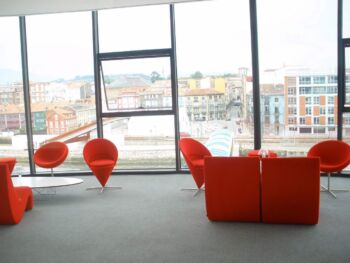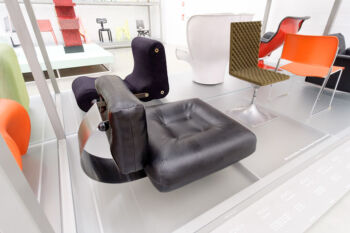Niemeyer’s unmistakable signature, its distinctive plastic form, made this desk designed for Estel not only a best seller, but also one of the few works the Brazilian architect dedicated to interior design.

Image source: https://commons.wikimedia.org/wiki/File:Aviles_-_Centro_Cultural_Internacional_Oscar_Niemeyer_21.jpg

Image source: https://www.flickr.com/photos/toasty/37012729091 Author:Kenneth Lu
The Collection
In the mid 1980s, Estel commissioned Oscar Niemeyer to design executive furniture. What he conceived fully interpreted the two-fold vocation of the Italian Design brand, being able to integrate and live both the home and office environment continuously. Estel Niemeyer table indeed fits both in living rooms areas as well as office executive rooms. The table represents the same aesthetic visible in Niemeyer’s architecture design: essential materials, solid curves, reflecting pools.

Image source: https://commons.wikimedia.org/wiki/File:Palacio_do_Planalto_Reception.jpg
The desk features a single sculptedl base, a leg made in wood covered with brushed stainless steel. The tabletop can be manufactured in a variety of forms and materials, which include either tempered glass or different solid wood options, 50 mm thick. It is equipped with an electrified extractable drawer which, rotating at 90 °, is positioned to the left of the operator and can be used to store items. Presented in the double version, it can reach a length of 4.5 meters.

Image source: https://commons.wikimedia.org/wiki/File:Tavolo_Niemeyer_Estel.jpg
About Niemeyer
Oscar Niemeyer (1907-2012) was a master of Modern Movement. His career began in the 1930s, when he collaborated with Lúcio Costa and Le Corbusier, and was truly inspired by these pioneers of modern architecture. Brasilia is the most impactful design by Niemeyer. The city is a futuristic utopia, a symbol of progress, characterized by curves and white concrete. Niemeyer mixed past elements with pilotis, brise-soleils, and glass, creating a new language. His style is recognizable in structures like the Cathedral or the Itamaraty Palace. Brasilia was the only 20th-century city recognized by UNESCO.

Image source: https://upload.wikimedia.org/wikipedia/commons/7/70/Oscar_Niemeyer_1968b.jpg
Later the military dictatorship forced the architect to exile and he moved to France. During this period he designed many important European buildings, including the Communist Party Headquarters in Paris and the Mondadori Editorial Office in Italy. Moreover, he in Algiers, where he designed the University of Constantine. Later masterpieces are the Niterói Contemporary Art Museum and the Niemeyer’s Eye. He died in 2012, at the age of 104 years old.
Info sources:
https://www.estel.com/en/product/niemeyer-en/
https://www.owo.biz/product/niemeyer-table/
